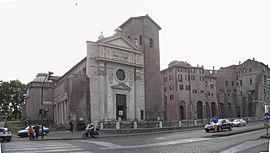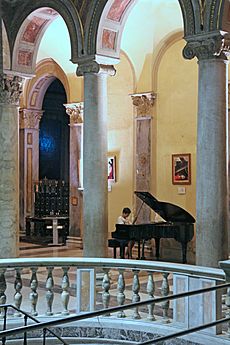San Nicola in Carcere facts for kids
Quick facts for kids San Nicola in Carcere |
|
|---|---|
| Basilica of Saint Nicholas in Prison | |
|
Basilica di San Nicola in Carcere
|
|

San Nicola in Carcere near Theatre of Marcellus
|
|
| 41°53′28″N 12°28′48″E / 41.89111°N 12.48000°E | |
| Location | Via del Teatro di Marcello 46, Rome |
| Country | Italy |
| Language(s) | Italian |
| Denomination | Catholic |
| Tradition | Roman Rite |
| History | |
| Status | titular church, minor basilica, regional church |
| Dedication | Nicholas of Myra |
| Architecture | |
| Architect(s) | Giacomo della Porta |
| Architectural type | medieval |
| Completed | 1599 |
| Administration | |
| Diocese | Rome |
San Nicola in Carcere (Italian, "St Nicholas in prison") is a titular church in Rome near the Forum Boarium in rione Sant'Angelo. It is one of the traditional stational churches of Lent.
Contents
History
The first church on the site was probably built in the 6th century, and a 10th-century inscription may be seen on a fluted column next to the entrance, but the first definite dedication is from a plaque on the church dating to 1128. The inscriptions found in S. Angelo, a valuable source illustrating the history of the Basilica, have been collected and published by Vincenzo Forcella.
It was constructed in and from the ruins of the Forum Holitorium and its Roman temples, along with a jail (carcer) which a tradition (supported by Pliny's history of Rome) states was sited in the temples' ruins. However, the in Carcere (in jail) part of the name of the church was only changed to "in Carcere Tulliano" in the 14th century, owing to an erroneous identification. The prison was really that of Byzantine times (LPD i.515, n13; ii.295, n12).
Spolia from all these ancient remains is still apparent in the church's construction, most particularly three columns from the Temple of Juno Sospita which are incorporated into both the 10th century and 1599 north façades of the church. The columns of the Temple of Janus, dedicated by Gaius Duilius after his naval victory at the Battle of Mylae in 260 BC, can still be seen as being incorporated into the wall of the church.
The dedication to St Nicholas was made by the Greek population in the area. In the 11th century, it was known as the church of Petrus Leonis, referring to the converted Jewish family, the Pierleoni, who rebuilt the nearby Theatre of Marcellus as a fortress. One of their members, Pietro Pierleone, was an important cardinal in the 1120s and was elected Pope Anacletus II, though he was later branded a schismatic antipope.
The church was rebuilt in 1599, with a new facade by Giacomo della Porta (though the medieval campanile - originally a fortified tower, then adapted to a bell tower after being abandoned - was not altered). Stairs under the altar lead to the crypt and to the base of the former Roman temples. Beneath the high altar is also an ancient basalt bath tub containing martyrs' relics.
Present
The church is known for celebrations to the devotion of the Madonna; one is the Italian Our Lady of Pompeii, whose feast is celebrated here, and the other is the Mexican Our Lady of Guadalupe, a reproduction of whose miraculous painting, sent here from Mexico in 1773, is shown.
Nearby structures include:
- Piazza Venezia
- Campidoglio
- Theatre of Marcellus
- Temple of Portunus in the Forum Boarium
- Santa Maria in Cosmedin and the Bocca della Verità
List of cardinal-deacons
- Ottaviano de Monticello (1138–1151)
- Ottone (1152–1174)
- Vibiano (1175)
- Gerardo (1175–1178)
- Bernardo (1178–1181)
- Pietro Diana (1185–1188)
- Egidio Pierleoni (1190–1194)
- Gerard OCist (1198–1199)
- Guido Pierleone (1205–1221)
- Otto of Tonengo (1227–1244)
- Giovanni Gaetano Orsini (1244–1277)
- Guglielmo Longhi (1294–1319)
- Giovanni Arlotti (1328), pseudocardinal
- Landolfo Maramaldo (1381–1415)
- Rodrigo Lanzol-Borja y Borja (1456–1484)
- Giovanni Battista Savelli (1484–1498)
- Amanieu d'Albret (1500–1520)
- Agostino Trivulzio, in commendam (1520–1531)
- Íñigo López de Mendoza y Zúñiga (1531–1537)
- Rodrigo Luis de Borja y de Castre Pinòs (1537)
- Girolamo Grimaldi, in commendam (1537–1538)
- Niccolò Caetani di Sermoneta (1538–1552)
- Giacomo Savelli (1552–1558)
- Giovanni Battista Consiglieri (1558–1559)
- Carlo Carafa (1560–1561)
- Francesco II Gonzaga (1561–1562)
- Georges d'Armagnac (1562–1585)
- Francesco Sforza (1585–1588)
- Ascanio Colonna (1588–1591)
- Federico Borromeo (1591–1593)
- Pietro Aldobrandini (1593–1604)
- Carlo Emmanuele Pio di Savoia (1604–1623)
- Carlo di Ferdinando de' Medici (1623–1644)
- Giangiacomo Teodoro Trivulzio (1644)
- Rinaldo d'Este (1644–1668)
- Friedrich von Hessen-Darmstadt (1668–1670)
- Paolo Savelli (1670–1678)
- Urbano Sacchetti (1681–1689)
- Gianfrancesco Ginetti (1689–1691)
- vacant (1691–1699)
- Henri Albert de La Grange d'Arquien (1699–1707)
- Lorenzo Altieri (1707–1718)
- Damian Hugo Philipp Reichsgraf von Schönborn-Buchheim (1721)
- vacant (1721–1728)
- Antonio Banchieri (1728–1733)
- vacant (1733–1738)
- Carlo Della Torre di Rezzonico (1738–1747)
- Mario Bolognetti (1747–1751)
- Domenico Orsini d'Aragona (1751–1763)
- vacant (1763–1770)
- Giovanni Battista Rezzonico (1770–1783)
- Romoaldo Braschi-Onesti (1787–1800)
- Marino Carafa di Belvedere (1801–1807)
- vacant (1807–1816)
- Pietro Vidoni (1816–1830)
- vacant (1830–1834)
- Nicola Grimaldi (1834–1845)
- Giuseppe Antonio Zacchia Rondinini (1845)
- Pietro Marini (1847–1863)
- vacant (1863–1874)
- Camillo Tarquini SJ (1874)
- Domenico Bartolini (1875–1876)
- Joseph Hergenröther (1879–1888)
- vacant (1888–1907)
- Gaetano De Lai (1907–1911)
- vacant (1911–1922)
- Giuseppe Mori (1922–1933) pro hac vice (1934)
- Nicola Canali (1935–1961)
- vacant (1961–1967)
- Patrick Aloysius O'Boyle pro hac vice (1967–1987)
- Hans Urs von Balthasar SJ (1988)
- vacant (1988–1994)
- Alois Grillmeier SJ (1994–1998)
- Zenon Grocholewski (2001–2020)
- Silvano Maria Tomasi (2020-present)
See also
 In Spanish: San Nicola in Carcere para niños
In Spanish: San Nicola in Carcere para niños



